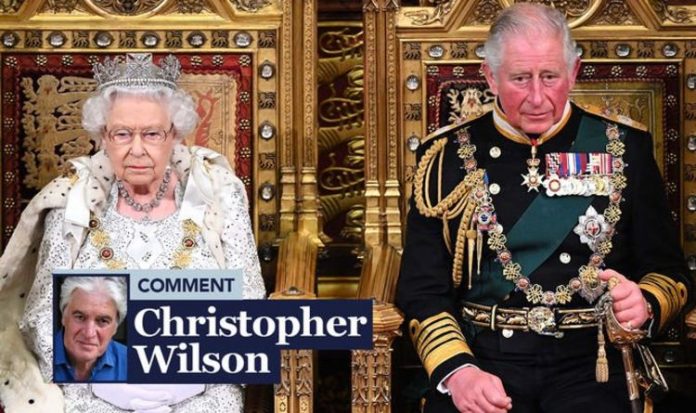
Prince Charles’ plans for monarchy (Image: Getty)
Earlier this month it was revealed that soon he’ll give up the 900 acres next to his Gloucestershire home where he started organic farming 35 years ago, and which is regarded as the birthplace of his famous Duchy Originals brand.
The reason Charles gave is that he won’t have the time to devote to farming once he becomes king.
Never before has that eventuality – sitting on the throne – formed a public part of his forward strategy.
He’s had plenty of time to think about it – he’ll be 72 in a couple of months, and has borne the title of Prince of Wales for 51 of those years.
No doubt as the years passed his plans for kingship have changed, and changed again. But one thing is certain – he’ll spend less and less time at Highgrove, his signature base for 40 years.
The traditional homes of the sovereign – Windsor, Balmoral, Sandringham – will claim his attention.
He’s particularly fond of the mansion he “saved for the nation” – Dumfries House in Ayrshire – and has other homes to call his own including Clarence House in The Mall, a small place in Wales, a bungalow in the Scilly Isles, and a house in Romania.
Most royal-watchers believe Charles will never live in Buckingham Palace, which he dislikes, and will remain with Camilla at Clarence House when in London.
But inevitably Highgrove will become surplus to requirement. Who’ll live there?

Prince Charles will give up the 900 acres next to his Gloucestershire home where he started organic farming 35 years ago (Image: Getty)
Neither of his sons have fond memories of the place where they watched their parents’ marriage collapse and, in any event, William and Kate are comfortable with their plush Norfolk abode. And Harry and Meghan are unlikely to be coming home any time soon.
Only 11 years from now our future king-but-two Prince George will come of age. Maybe he’ll take a liking to the elegant 18th century Cotswold stone house and its surrounding estate. But in his statement saying goodbye to his beloved Home Farm, Charles signalled the closing of a door in his life.
What, then, of his future as king?
Though its meetings remain a state secret, a group of influential figures convene regularly under the codename Golden Orb to make sure everything is in place the day Charles does become king – the oldest monarch to take the crown.
This committee of the great and good is shrouded in mystery – it’s not known how many members there are, where they meet, or how often.
However the names of some of the key players have emerged, albeit discreetly, and they include the group’s chairman, the 63-year-old Duke of Norfolk who, as hereditary Earl Marshal, takes ultimate responsibility for the Coronation.

Most royal-watchers believe Charles will never live in Buckingham Palace (Image: Getty)
By his side is Thomas Woodcock, the 69-year-old Garter Principal King of Arms, who as chief royal herald, has an important part to play in the Westminster Abbey ritual that dates back to 1066 and beyond.
Then comes the chief of the defence staff, General Sir Nicholas Carter, whose responsibility it will be to line the coronation route with soldiery – and ensure the safe protection of all who attend or witness the ceremony.
The Archbishop of Canterbury, Justin Welby, and Home Secretary Priti Patel are among the dozen or so other members of the committee.
The one crucial issue that certainly won’t be on their monthly agenda, instead limited to a very few key players indeed, will be the important question – one crown, or two?
The latest word from Clarence House, a repetition of the pledge made at the time of Charles’s 2005 marriage, is that Camilla will not be styled Queen Camilla, but Princess Consort, in deference to the feelings of those followers of Princess Diana.
She will not be crowned and anointed in the way the Queen Mother, the last queen consort, was at the 1937 coronation.
But there’s a burning desire among some senior Palace officials that the door should remain open and that if public goodwill swings behind the idea of a Queen Camilla in the hours and days following Charles’s accession, then a second throne will be taken out of mothballs and the consort’s crown will be polished up for the big day.
“This key decision will be taken in the light of public opinion at the time. It’s too early to call at this stage,” I am told.
The final matter, surprisingly, is what Charles will call himself.
The last king to be crowned was called Bertie, but styled George VI. The one before him went by the name David but was crowned Edward VIII.
There is, as yet, no guarantee that Charles will be crowned King Charles III.
George VI’s title was chosen in the light of Edward VIII’s abdication the previous year – the choice a hark back to the solid and dependable reign of King George V.
Charles will enter the stage in different circumstances, following the lengthy and – say many – the most successful reign in the long story of British monarchy.
Queen Elizabeth II’s reign will be an impossibly hard act to follow. There’ll be no time for welly boots at Highgrove as the new king sets out to leave his mark on history…







